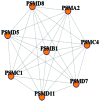Differential network as an indicator of osteoporosis with network entropy
- PMID: 29896257
- PMCID: PMC5995033
- DOI: 10.3892/etm.2018.6169
Differential network as an indicator of osteoporosis with network entropy
Abstract
Osteoporosis is a common skeletal disorder characterized by a decrease in bone mass and density. The peak bone mass (PBM) is a significant determinant of osteoporosis. To gain insights into the indicating effect of PBM to osteoporosis, this study focused on characterizing the PBM networks and identifying key genes. One biological data set with 12 monocyte low PBM samples and 11 high PBM samples was derived to construct protein-protein interaction networks (PPINs). Based on clique-merging, module-identification algorithm was used to identify modules from PPINs. The systematic calculation and comparison were performed to test whether the network entropy can discriminate the low PBM network from high PBM network. We constructed 32 destination networks with 66 modules divided from monocyte low and high PBM networks. Among them, network 11 was the only significantly differential one (P<0.05) with 8 nodes and 28 edges. All genes belonged to precursors of osteoclasts, which were related to calcium transport as well as blood monocytes. In conclusion, based on the entropy in PBM PPINs, the differential network appears to be a novel therapeutic indicator for osteoporosis during the bone monocyte progression; these findings are helpful in disclosing the pathogenetic mechanisms of osteoporosis.
Keywords: network entropy; osteoporosis; peak bone mass; protein-protein interaction networks.
Figures



Similar articles
-
Key genes associated with osteoporosis revealed by genome wide gene expression analysis.Mol Biol Rep. 2014 Sep;41(9):5971-7. doi: 10.1007/s11033-014-3474-1. Epub 2014 Jul 4. Mol Biol Rep. 2014. Retraction in: Mol Biol Rep. 2015 Oct;42(10):1471. doi: 10.1007/s11033-015-3899-1. PMID: 24993113 Retracted.
-
[Analysis of genes related to female bone peak and osteoporosis based on bioinformatics].Zhongguo Gu Shang. 2023 Sep 25;36(9):866-72. doi: 10.12200/j.issn.1003-0034.2023.09.014. Zhongguo Gu Shang. 2023. PMID: 37735080 Chinese.
-
An in vivo genome wide gene expression study of circulating monocytes suggested GBP1, STAT1 and CXCL10 as novel risk genes for the differentiation of peak bone mass.Bone. 2009 May;44(5):1010-4. doi: 10.1016/j.bone.2008.05.016. Epub 2008 May 28. Bone. 2009. PMID: 19223260
-
The peak bone mass concept.Clin Rheumatol. 1989 Jun;8 Suppl 2:16-21. doi: 10.1007/BF02207228. Clin Rheumatol. 1989. PMID: 2667868 Review.
-
Influence of Adolescents' Physical Activity on Bone Mineral Acquisition: A Systematic Review Article.Iran J Public Health. 2016 Dec;45(12):1545-1557. Iran J Public Health. 2016. PMID: 28053920 Free PMC article. Review.
Cited by
-
Network and pathway-based analyses of genes associated with osteoporosis.Medicine (Baltimore). 2020 Feb;99(8):e19120. doi: 10.1097/MD.0000000000019120. Medicine (Baltimore). 2020. PMID: 32080087 Free PMC article.
References
-
- Czerwiński E, Badurski JE, Marcinowska-Suchowierska E, Osieleniec J. Current understanding of osteoporosis according to the position of the World Health Organization (WHO) and International Osteoporosis Foundation. Ortop Traumatol Rehabil. 2007;9:337–356. - PubMed
-
- Lei SF, Wu S, Li LM, Deng FY, Xiao SM, Jiang C, Chen Y, Jiang H, Yang F, Tan LJ, et al. An in vivo genome wide gene expression study of circulating monocytes suggested GBP1, STAT1 and CXCL10 as novel risk genes for the differentiation of peak bone mass. Bone. 2009;44:1010–1014. doi: 10.1016/j.bone.2008.05.016. - DOI - PubMed
-
- Udagawa N, Takahashi N, Akatsu T, Tanaka H, Sasaki T, Nishihara T, Koga T, Martin TJ, Suda T. Origin of osteoclasts: Mature monocytes and macrophages are capable of differentiating into osteoclasts under a suitable microenvironment prepared by bone marrow-derived stromal cells. Proc Natl Acad Sci USA. 1990;87:7260–7264. doi: 10.1073/pnas.87.18.7260. - DOI - PMC - PubMed
LinkOut - more resources
Full Text Sources
Other Literature Sources
